

A Chronology of Lord Peter Wimsey Stories
I created this page because back when I started reading the Peter Wimsey stories - around 1999 - I wanted to know what order to read them in. To my surprise, no one had assembled such a page on the Web. So I decided to give it a shot myself. The goal of this chronology is to provide a guide for the order in which the stories should be read, and therefore I've avoided giving spoilers in this chronology.(I've also been doing the same for Margery Allingham's Albert Campion series.)
Stories in italics are novels, while those in "quotes" are short stories. All the short stories can be found in the volume Lord Peter. The short stories rarely give a clue as to when they occur, so I've kept them in the order in which they appear in that volume unless the story gives me reason to place it elsewhere.
| Year | Story | Comments |
|---|---|---|
| 1921 | "The Vindictive Story of the Footsteps that Ran" | Early in the story is the sentence, "It was a Sunday afternoon in that halcyon summer of 1921." This then is the chronologically earliest Lord Peter story, although "Copper Fingers" has a flashback which occurs in 1920. |
| 1923 | Whose Body? | The first published Lord Peter story. Peter was born in 1890, so is 32 in this novel, which takes place in November. |
| 1924 | Clouds of Witness | Despite a 1927 copyright, this story takes place only about a year after Whose Body? Peter is referred to as being 33 in the story, which takes place in October and November. The first few pages make it clear that no short stories could have occurred between this novel and its predecessor. |
| 1924 | "The Abominable History of the Man with the Copper Fingers" | The bulk of this story occurs in 1920, according to the text, but it's told in flashback and probably occurs around this time. |
| 1925 | "The Entertaining Episode of the Article in Question" | The text states that it occurs in April. |
| 1925 | "The Fascinating Problem of Uncle Meleager's Will" | The text states that it occurs in June. |
| 1925 | "The Fantastic Horror of the Cat in the Bag" | |
| 1925 | "The Learned Adventure of the Dragon's Head" | Peter's nephew, St. George, is 10. As he is at university in Gaudy Night, which occurs in 1935, and is described by Harriet as being not more than "21 or 22", so this story likely occurred in 1925. |
| 1926 | "The Unprincipled Affair of the Practical Joker" | |
| 1927 | Unnatural Death | Miss Climpson's letter in Chapter IV states that the story begins around April, 1927. |
| 1927 | "The Bibulous Business of a Matter of Taste" | |
| 1927 | "The Piscatorial Farce of the Stolen Stomach" | |
| 1928 | "The Unsolved Puzzle of the Man with No Face" | The victim of this story is supposed to have been on a swimming holiday, therefore it likely occurred in summer. |
| 1928 | The Unpleasantness at the Bellona Club | Takes place in the weeks following Armistice Day, which is November 11 (the date of the German surrender in World War I, now called Veteran's Day in the US). |
| 1928 | "The Undignified Melodrama of the Bone of Contention" | Between Bellona Club and Strong Poison Parker was promoted from Detective-Inspector to Chief Inspector (possibly due to the events of "The Cave of Ali Baba"). In this story Parker is a Chief Inspector, and the story states that it occurs in November, so it barely fits into November, 1928. |
| 1928-1930 | "The Adventurous Exploit of the Cave of Ali Baba" | This story spans two years, from Wimsey's "death" until the events of the text. Peter is referred to at the beginning of the story as being 37, and having died "the previous December" - presumably 1928. If Peter was born in 1890, then this math doesn't quite work, but we can allow for a little poetic license. |
| 1930-31 | Strong Poison | The first Harriet Vane story. For plot reasons, this novel must follow "Ali Baba", and therefore all of the other early short stories (collected in Lord Peter Views the Body) must come before it as well. New Year's Day 1931 passes during the course of the novel. |
| 1931 | "The Image in the Mirror" | |
| 1931 | "The Incredible Elopement of Lord Peter Wimsey" | |
| 1931 | The Five Red Herrings | |
| 1931 | "The Queen's Square" | Occurs during the winter, as there is snow on the ground. |
| 1932 | Have His Carcase | The chapters are precisely set by month and date; the adventure starts June 18. In Chapter 3, Harriet refers to herself to the press as "the Harriet Vane who was tried for murder two years ago", this setting the year. |
| 1932 | "The Necklace of Pearls" | Occurs at a Christmas party. |
| 1933 | Murder Must Advertise | The victim died in May, and this story takes place a few weeks later, over the course of a month. |
| 1933 | "In The Teeth of the Evidence" | |
| 1933-34 | The Nine Tailors | An event early in the book is placed on Saturday, January 4, but January 4 was not a Saturday in any of the years from 1932 to 1935. It did fall on a Saturday in 1930 and 1936, but the former conflicts with "The Cave of Ali Baba"'s chronology, and this novel almost certainly occurs before Gaudy Night. So it appears Sayers erred. As this book clearly occurs during the Great Depression, it seems reasonable to assume that the bulk of it occurs during the year it was written - 1934. |
| 1934 | "Striding Folly" | |
| 1935 | Gaudy Night | The Author's Note states that the book occurs in 1935, and Chapter II states that Wimsey is 45. The story occurs during the first half of the year. Chapter IV observes that Harriet went travelling shortly after the events of Have His Carcase, returning around June 1933 to write two novels and several stories based on her experiences, and that she and Peter had only sporadic meetings since then. |
| 1935 | Busman's Honeymoon | Seems to occur in the same year as Gaudy Night; it doesn't seem likely that they'd have waited more than a year after their engagement to marry, and the novel states that Peter is (still) 45. Peter and Harriet are wed on October 8, and the novel mostly occurs in the few days following. |
| 1936 | Thrones, Dominations | Begins in January, runs through late March. |
| 1936 | "The Haunted Policeman" | Peter and Harriet's son Bredon is born just before the story begins (the Author's Note in Thrones, Dominations gives this date as 15 October), and Peter states that he and Harriet have been married for a year. |
| 1942 | "Talboys" | Peter and Harriet's son Bredon is stated to be six, and Peter to be 52. Their son Paul is four, and their youngest son Roger's age is not given, but the Author's Note in Thrones, Dominations states that he was born in 1941. |
| Later | The only knowledge we have of Peter and Harriet's later lives is from the Author's Note in Thrones, Dominations, which states that Peter served in Military Intelligence during World War II, and Harriet published a monograph on Sheridan Le Fanu around 1946. Peter would have been 62 when Queen Elizabeth II ascended to the English throne in 1952. One can only assume that he would have continued serving his crown and country as he always had, that that he would have bourne the changes in the world through the 50s and 60s with the good graces he always displayed in his chronicled adventures. |
Some Background on Lord Peter WimseyThe Lord Peter stories were published between 1920 and 1940 and concern the younger brother of the Duke of Denver, Peter Death Bredon Wimsey. Wimsey was born in 1890 and served in World War I. During the war he was injured and suffered a bad case of shell shock for several months afterwards. He eventually recovered, and his compatriot in the war, Bunter, afterward was employed as Wimsey's manservant.Wimsey's position leaves him financial well-to-do, and he lives primarily in a flat in London, where he collects rare books. At the beginning of the series he is a confirmed bachelor. He began investigating crime as a hobby sometime prior to the earliest published stories, and he's become known to the police as a competent sleuth, especially to his friend Detective-Inspector Parker. |
||
| Click on a book's image or title to order from Amazon.com |
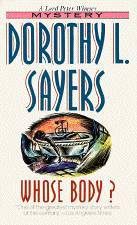
Whose Body?
Harper, PB, © 1923, 212 pp, ISBN #0-06-104357-5Reviewed February 2000
What It's About: Mr. Alfred Thipps one day finds a dead body in his bathtub. He's never seen the body before, and has no idea who it is, or how it got there. Wimsey inserts himself into the investigation - to the consternation of Inspector Sugg, who doesn't much like him. It turns out that a visible financier has disappeared around this time, and the police figure that the body must him (although they're unable to prove it), and that Thipps must somehow be behind it (despite being a mouse of a man with no known connection to the financier). This, of course, would be too easy, and Wimsey goes about determining who's behind it.
What I Thought of It: The mystery in this novel is reasonable enough, but it's a shorter book than any other in the series, so the mystery is slighter. None of the series' recurring characters are present other than Wimsey, Bunter, and Inspector Parker, and Wimsey's speech patterns are considerably more casual, dropping the 'g' from 'ing' sounds, so he says interestin', makin', lettin' 'em, really most awfully sorry, and so forth. (In later books he speaks in more measured, formal tones.)
It's an interesting introduction to Wimsey's world, but is a slight volume and not very polished.
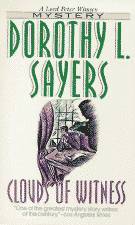
Clouds of Witness
Harper, PB, © 1927, 279 pp, ISBN #0-06-104353-2Reviewed April 2000
What It's About: Following the events of Whose Body?, Peter and Bunter go on a vacation, but return when Peter learns that his brother Gerald, the Duke of Denver, is accused of murdering their sister Mary's fiance. The Duke was entertaining a variety of guests at the family home that night and the fiance was shot in the dead of night, and Gerald was found examining by Mary the body. Gerald refuses to discuss the matter in much depth, and clearly most involved parties have something to hide. Peter approaches the mystery from both the physical evidence and the characters and backgrounds.
What I Thought of It: A fine book which provides perhaps the most broad-ranging view of Peter's background and life, especially regarding his family and Inspector Parker. A terrific balance between the mystery and the characters, I was even pleased to find myself a few steps ahead of Peter at a couple of points, though not all the way through. Unfortunately the book is marred by a somewhat disappointing solution to the mystery, but overall it's quite enjoyable.
This is a good first book to read in the Wimsey series, if you're new to it.
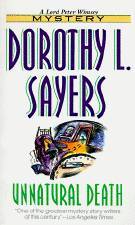
Unnatural Death
Harper, PB, © 1927, 264 pp, ISBN #0-06-104358-3Reviewed April 2000
What It's About: Peter and Parker meet a young doctor at dinner, and he tells them of an elderly woman he cared for three years earlier who mysteriously died while under his care. He raised suspicions of murder, but could not prove anything, which combined with the woman's age damaged his reputation in the eyes of many. Peter smells something fishy and decides to investigate, sending his friend Miss Climpson - a spinster who does covert investigating on Peter's behalf - to the town in question to find some facts about the woman, her nurse, and the murder of one of the housekeepers who had worked there at the time.
What I Thought of It: Not so much a "whodunnit" as a "was anything 'dun' at all?", this novel is notable for introducing Miss Climpson and her chatty manner of befriending people who might know something about the goings-on that Peter is investigating. Peter builds a case on the thinnest evidence and manages to flesh it out, with a nifty manhunt at the very end. It's a fun romp, but overall rather inconsequential.
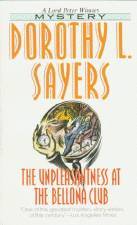
The Unpleasantness at the Bellona Club
Harper, PB, © 1928, 243 pp, ISBN #0-06-104354-0Reviewed April 2000
What It's About: The aged General Fentiman is found dead one morning at the Bellona Club, an exclusive group to which Peter belongs. As he was ninety years old, no one wonders much about it until it turns out that one Lady Dormer died within a day of the General, and her considerably fortune would pass on to him (or rather, his heirs) if he was living at the time of her death, else it would be passed to a young woman named Miss Dorland. So the exact hour of the General's death turns out to be significant. Peter is enlisted to investigate exactly how long he had been dead, and finds that not everything about the body is as it at first seemed, and that a variety of people had motives for rigging the circumstances of the General's death.
What I Thought of It: With its Bridge-themed chapter titles, this is quite an entertaining book, expanding Peter's world to his friends and acquaintances at the Bellona Club. (The reader can also be amused by the fact of a woman - Sayers - writing about an exclusive men-only British club.) The General's sons, Robert and George, are friends of Peter's and are obvious suspects, as is Miss Dorland, and Sayers does a fine job of playing up the muddiness involving the behaviors of these three. The book is just about the right length, and although the mystery itself is not as meaty as in Clouds of Witness, the resolution is ultimately more satisfying.
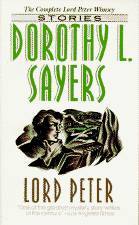
Lord Peter
Harper, PB, 481 pp, ISBN #0-06-104361-3Reviewed December 2000
What It's About: Lord Peter includes every short story Sayers published starring Lord Peter Wimsey. Included is "The Abominable History of the Man with Copper Fingers", with a flashback to Wimsey's earliest recorded adventure, "The Adventurous Exploit of the Cave of Ali Baba", which bridges the 1920s and the 1930s Wimsey tales, and two stories which occur after the last novel, Busman's Honeymoon, one of which features their eldest son Bredon prominently.
Most of these stories also appear in other collections: Lord Peter Views the Body, In The Teeth of the Evidence and Hangman's Holiday. But Lord Peter is the whole enchilada.
What I Thought of It: For all the fun Sayers pokes at Conan Doyle's Sherlock Holmes stories, this collection makes it clear that she was still influenced by the Great Detective's adventures, as many stories herein turn on clever little tricks of timing or ingenious gimmicks to pull off a caper. Sometimes Sayers plays fair, and other times she doesn't, relying on some trick which a reader probably neither knows nor cares about. The pivotal story here is "Ali Baba", which fills in an interesting gap in the middle of Wimsey's career and should be read just before Strong Poison. "Talboys" is also notable as it gives us a look at what sort of a father Peter turns out to be (much the same as the kind of uncle he is portrayed as in "The Learned Adventure of the Dragon's Head"). Otherwise, the stories are mostly not terribly notable, though a nice way to pass the time, although "The Incredible Elopement of Lord Peter Wimsey" is a departure in that it ranges a bit into the territory of the horror yarn.
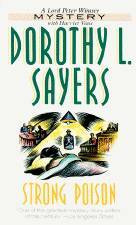
Strong Poison
Harper, PB, © 1930, 261 pp, ISBN #0-06-104350-8Reviewed April 2000
What It's About: Lord Peter attends the trial of Harriet Vane, a young mystery writer accused of poisoning her former lover, Philip Boyes. Peter's friend Miss Climpson is on the jury, and has doubts of her guilt, so the jury is hung and Harriet will be re-tried. Peter, too has his doubts, and also finds himself falling in love with Harriet after interviewing her, so he sets out to clear her. Peter interviews Boyes' father, as well as Norman Urquhart, the solicitor whom Boyes had last dined with (he even installs an employee of Miss Climpson undercover at his firm), and meets some of the people in the artists' circles which Boyes hung around with. And yet, with Urquhart cleared and circumstantial evidence pointing to Harriet, things seem bleak.
What I Thought of It: This novel exists primarily to introduce Harriet Vane as Peter's true love interest. It's no surprise that she is, in fact, innocent, as she plays a key role in later books. The mystery itself, however, is rather drab, having points in common with Bellona Club and Unnatural Death. Vane doesn't appear much in the story, and the characters take a back seat to the plot, which makes it less lively than usual. Overall it's not one of the stronger entries in the series.
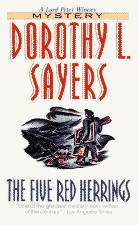
The Five Red Herrings
Harper, PB, © 1931, 354 pp, ISBN #0-06-104363-XReviewed August 2000
What It's About: Peter Wimsey is vacationing in Galloway in Scotland, a favorite location of many painters. The morning after a row between the feisty Campbell and Wimsey's English friend Waters, Campbell turns up dead in the water at the bottom of a cliff, and besides Waters there are five others in the area who hated Campbell's guts and might have killed him. The event was clearly dressed up to appear to be a suicide, and someone impersonated Campbell from afar to make it appear he died at a time other than when he did. Wimsey investigates all the suspects and the evidence to unearth the murderer.
What I Thought of It: The least character-driven of the Wimsey novels, this is Sayers doing a pure take on Sherlock Holmes, with a lush backdrop and a complicated mystery with a large number of plausible suspects. Although perhaps a bit too long, it's very well executed and accomplishes what it set out to do. There are issues of timing and distance, matters of motivation and suspicion, and clues in the habits of the suspects. Very neatly put together, it may be disappointing to those who read Wimsey for the characters (especially fans of the Harriet Vane books), but for pure mystery buffs, it's quite good.
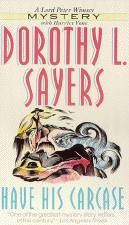
Have His Carcase
Harper, PB, © 1932, 440 pp, ISBN #0-06-104352-4Reviewed October 2000
What It's About: On vacation while working on her new novel, Harriet Vane finds the body of a gentleman dancer from the nearby town of Wilvercombe on a rock on the beach a low tide. His throat has been slit, and a razor lies at the base of the rock, blood flowing copiously. Unable to save the body from the high tide, Harriet gathers evidence, which she presents to the police. Peter reads of the event in the paper, and shows up to help out (and to woo Harriet, of course). Peter and Harriet suspect murder, although the police suspect suicide. It turns out the victim was a Russian exile who had recently engaged a wealthy widow. There are plenty of suspects about the sea-side town, but all have alibis.
What I Thought of It: Perhaps over-long, this is nonetheless a good mystery, hinging on timing and the very brazenness of the crime. Peter and Harriet measure and time distances, investigate everyone who could possibly have seen everything, and spend much of the time thoroughly bewildered by a complicated chain of events (or maybe, not so complicated after all?). There's even a neat aside where a straightforward yet (in the 1930s) tough-to-crack ciphering scheme is explained. The book's other flaw (besides its rambling length) is that the ultimate fate of some of the principals is left maddeningly vague, but at least we feel fairly confident that we know what happened.
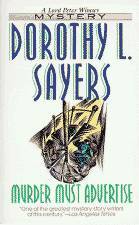
Murder Must Advertise
Harper, PB, © 1933, 356 pp, ISBN #0-06-104355-9Reviewed October 2000
What It's About: Advertising copy-writer Victor Dean falls down some stairs and dies at Pym's Publicity one day. A few weeks later, a man named Death Bredon (in reality, our dashing hero) fills his shoes and begins inquiring about the circumstances of Dean's life, times, and demise. Dean had been running with Dian de Momerie's crowd of thrill-seekers and drug-consumers, and might have been blackmailing someone at Pym's. Before it's over, Peter gets involved with drug-smugglers, impersonates his fictional cousin, goes for a night-time car race, and plays in a cricket match.
What I Thought of It: One of the cleverest Wimsey stories in its presentation of the advertising field (in which Sayers worked for some years) and its tying in with the overall plot. (This novel and its two predecessors all rely on fairly complex schemes which Wimsey and company have to carefully unravel.) This is Wimsey at his lightest touch, and this book is best read after some of the earlier ones, or it might give you an unusual feel for the character. With proper understandingly, Wimsey's cavorting at Pym's and for de Momerie is delightful, and more enjoyable than the endless brooding surrounding Harriet Vane. The ending is rather cold-blooded, however, which makes for a sharp contrast, but the resolution is actually one of Sayers' stronger finishes.
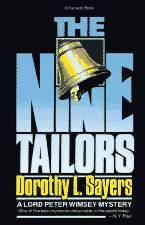
The Nine Tailors
Harcourt Brace Jovanovich, PB, © 1934, 310 pp, ISBN #0-15-665-899-2Reviewed November 2000
(This is the one Wimsey mystery not available in Harper's line. As I write this, the current edition is oversized paperback; I sought out a smaller used copy to line up on my bookshelf with the others.)
What It's About: One New Year's Eve, Peter and Bunter are stranded in the rural village of Fenchurch St. Paul. The rector of the local church provides hospitality, and in return Peter spends the night ringing church-bells in an ambitious nine-hour project, filling in for a ringer who is one of several villagers struck with influenza. A few months later, the husband of one of the flu victims himself dies, and in being buried with his wife, an unknown body is found to be buried atop her casket. Wimsey is invited to investigate, and becomes embroiled in an attempt to recover an emerald necklace stolen back in 1914, the church's bells being touted as clues to the mystery.
What I Thought of It: Sayers frustrates late-20th century American readers by naming her chapters after bell-ringing terms without ever explaining what they all mean. Thankfully, the mystery doesn't turn on knowing any of this except for a very basic principle which is explained. It's a dark and moody story with plenty of tragedy to go around, but although it starts very slowly, it picks up in the middle, and has a clever resolution at the end. Sayers' method of dispensing justice is rather heavy-handed, though. Alas, I think that the stories that take Wimsey out of his usual London milieu are less interesting than ones that see him in his element, as the supporting cast is rarely as rich.
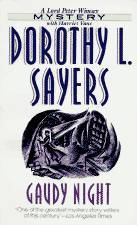
Gaudy Night
Harper, PB, © 1936, 501 pp, ISBN #0-06-104349-4Reviewed November 2000
What It's About: Harriet Vane travels to Oxford to attend The Gaudy, a reunion party at her fictional college of Shrewsbury. While there, she encounters two vicious letters targeting women at the college, including one referring to her murder accusation of several years earlier. A few weeks later she's called back by the Dean to investigate continuing disruptions, including many more poison pen letters, vandalism of a renovation of the library, and an electricity outage. She meets Peter's nephew Saint-George, and has another male student develop a crush on her, and a student at the college is driven to attempt suicide. Eventually she reluctantly invites Peter in to aid in the investigation, which turns on behavior in academia.
What I Thought of It: A unique Wimsey book in that it doesn't kick off with a murder, Gaudy Night is tediously long and dearly in need of editing for length. The mystery is rather perfunctory, and the book is mostly an exercise in plumbing the depths of Harriet's mind and her feelings for Peter, about which everyone around her seems aware. (Peter is conveniently off-stage on continental Europe for the first half of the novel.) Alas, I find Harriet to be a rather bland character; although she's clearly intelligent, independent and strong-willed, as a fictional protagonist she's not at Wimsey's level and just can't drive a book on her own. Although the ongoing courtship between Peter and Harriet comes to a head here, it's just not enough of a payoff. This is perhaps my least favorite of the Wimsey novels.
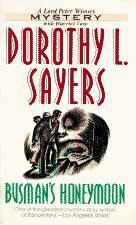
Busman's Honeymoon
Harper, PB, © 1937, 403 pp, ISBN #0-06-104351-6Reviewed December 2000
What It's About: Following their wedding, Peter and Harriet retreat to Talboys, a house near Harriet's childhood home which Peter has bought for her. The previous owner, Mr. Noakes, is mysteriously absent when they arrive, and soon turns up dead in the cellar, and in a considerable amount of debt to creditors as well as his gardner, Crutchley, and niece, Miss Twitterton. Superintendent Kirk looks into the case, the last man having seen Noakes alive having been his constable, Sellon, who at first lies about it. Meanwhile Peter and Harriet have trouble focusing on it owing to conflicts between a sense of duty to investigate and an obligation to start their new relationship.
What I Thought of It: The mystery here is slight indeed, turning on an entirely mechanical concept of how the murder was committed, and except for some bits focusing on Kirk and his investigation. The supporting cast is generally either thin or unlikeable, and the mystery doesn't even really begin until a quarter of the way through the book! The focus of the novel is primarily on Harriet and Peter and their relationship, which is decidedly rocky as they're of two minds as to whether Peter should investigate the murder, and still rather shell-shocked that they've actually gotten married. Some of this is genuinely believable and touching, but it gets tiresome at times, when Peter is singing (or talking) in French. The book ends with a 30-page denouement where Harriet visits Duke's Denver, and Peter rather implausibly agonizes over the results of his investigation. That whole section was entirely unrewarding and could have been snipped from the book wholesale. Overall, this is a bit better than Gaudy Night, but still quite disappointing.
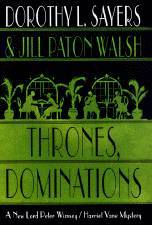
Thrones, Dominations
finished posthumously by Jill Paton WalshSt. Martin's Press, PB, © 1998, 322 pp, ISBN #0-312-96830-2
Reviewed December 2000
What It's About: Peter and Harriet go to France after their honeymoon at Talboys, where they meet another recently-married couple, the wealthy Laurence Harwell and his wife Rosamund. Laurence backs plays for a hobby, with mixed success, while Rosamund's father spent several years in prison for allowing unscrupulous people to do illegal things in his name. Nonetheless, they are deeply in love. However, their marriage is strained by Rosamund's desire for Laurence to back a play by Claude Amery, her "pet poet", and her sitting for the amorous French painter Gaston Chapparelle. One day, Rosamund is found murdered in the Harwells' country retreat. Thanks to the Wimseys' acquaintance with the Harwells, Peter investigates her murder.
What I Thought of It: Thrones, Dominations was unfinished by Dorothy Sayers during her lifetime, and finished in the 1990s by Jill Paton Walsh. Although it contains what seem obvious nods to modern sensibilities (for instance, frank discussions of sex, where the topic was taboo save for the most oblique references in earlier novels), it's still very much in keeping with the tone of the Wimsey novels. (Indeed, it avoids the extended asides which lengthened the later novels unduly and thus reads more like the entertaining earlier books). Harriet's encounter with Peter's relative Lady Severn is fall-down funny, as is her ripostes with Helen, Duchess of Denver. The ongoing negotiations between Peter and Harriet over her career and his sleuthing hobby become a bit tiresome, especially after several hundred pages of the same in Busman's Honeymoon, although the respect they have for each other is always enjoyable and enlightening. As for the mystery itself, it's comparatively slight, although fine for what it is, though the culprit seems rather obvious from the outset and the motivations thereof a bit unsatisfying. Overall, Thrones, Dominations is a fine addition to the Wimsey oeuvre, perhaps most disappointing in that it leaves us ignorant of the Wimseys' later years.
Jill Paton Walsh has also written an all-new mystery in the series, A Presumption of Death (2003). I have not read it, and I'm not sure I want to, since on I'm not generally in favor of new authors carrying on series by a previous author. Besides which, as I'm not a fan of Harriet Vane, I have little interest in reading further stories about her and Wimsey's married life. If this is Walsh's last Wimsey novel, then I may read it at some point, but if she starts producing her own Wimsey series, then I probably will just leave off with Thrones, Dominations.
Finally, I sometimes get questions about other Sayers books which are not listed above. There are a few:
Lord Peter Views the Body, Striding Folly Hangman's Holiday, and In the Teeth of the Evidence are all short story collections. The first two are Wimsey stories, while the last two contain some Wimsey stories and other unrelated stories (Sayers had another series of short stories about a detective named Montague Egg). All of these stories are included in Lord Peter (and, for that matter, in Dorothy L. Sayers: The Complete Stories), so if you only want to read the Wimsey stories, then these four collections are superfluous.
The Documents in the Case is a novel by Sayers and Robert Eustace, unrelated to the Wimsey stories.
Sayers was also noted for her translation of Dante's The Divine Comedy, and wrote a miscellany of other non-fiction works.
Other Dorothy L. Sayers Web Sites
hits since 13 August 2000.